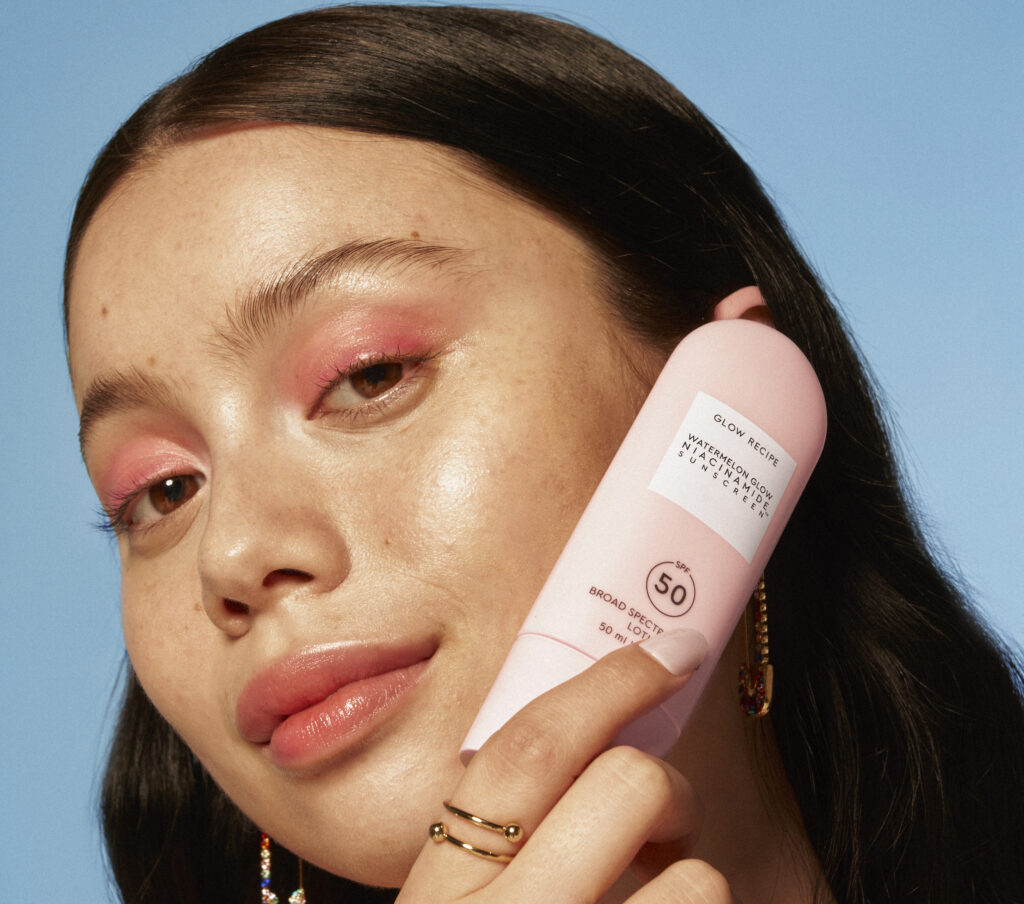
Sunscreen is one of the most important skincare products in a routine. In fact, you could argue that it’s the most important, since it’s in charge of everything from defending against sun damage, protecting against skin cancer, and even reversing sun damage, according to recent research. All good, right?

But a key piece to reaping all of those benefits is to use sunscreen properly — which can be harder than it might seem. Sunscreen testing is predicated on the assumption that you’re using it properly; if you skimp in one area or forget to reapply, you might not be getting the full SPF listed on the bottle. And, as a result, you might not be fully protected against the many worrisome effects of sun exposure. With the launch of our Watermelon Glow Niacinamide Sunscreen SPF 50, here’s how we recommend applying it to both get the best results and keep yourself safe — and your skin, glowing and healthy.
Pause after your skincare routine
Slow and steady wins the race, particularly when it comes to a good sunscreen application. Rather than rushing through your skincare routine, take a few moments between applying your primary products, such as your serum and moisturizer, and slathering on your sunscreen.
Otherwise, all those moisturizing formulas could create a pile-up on the skin’s surface, since skin can’t absorb so much at once. That leads to pilling — meaning none of it ultimately gets in. Waiting a minute or two for moisturizer to adequately sink in (and spending that time brushing your teeth or filling in your brows) allows your sunscreen to absorb that much better, too. Then, after applying SPF, wait for it to set before makeup application to prevent pilling.
Apply the right amount for you
There’s a ton of advice out there for how much sunscreen to apply, from a shot glass’s worth for the whole body to the two-finger rule for the face. For starters, you should have enough to cover both your face and neck. And we’ve found that instead of arbitrary recommendations, it’s better to simply apply a little more than how much moisturizer you use. (So, if you use a quarter-sized amount of moisturizer, go up to a half-dollar coin-sized amount for your sunscreen.)
That’s because of all your skincare products, people tend to apply the most amount of moisturizer. But that exact amount can look different for everyone, which is why using it as a reference point ensures you’ll have enough sunscreen for your skin. Plus, you can always layer on more if you know you’ll be out in the sun or don’t think you covered your neck entirely.
Work in sections
Once you dispense the right amount of sunscreen for you — again, whatever that looks like — it’s best applied in sections. Dab it onto your forehead, nose, cheeks, chin, neck, and décolletage, then use (clean) fingers to blend and pat (don’t rub) it into each area.
By working in sections, you can ensure you haven’t missed any spots. Plus, it can be a gamechanger when you’re using formulas with mineral actives; doing so ensures you blend it in properly so it doesn’t leave a cast. Applying it over facial hair? Dab it on in little dots and pat it in gently with your fingertips.
Don’t forget your neck and décolletage
Speaking of missing spots: While the face gets all the protection, the neck and chest typically get overlooked. And that’s not ideal, seeing as they’re often just as exposed to sunlight on a daily basis as your facial skin. They’re also just as susceptible to fine lines, dark spots, and other signs of photoaging.
Plus, they don’t get the benefit of the same oil glands as the face, so the skin barrier doesn’t get that built-in moisture. Compound that with the skin on the chest being some of the thinnest on the body, and you’ve got yourself a recipe for crepe-y, wrinkled-looking skin. Extending your sunscreen down to the neck and chest can be a game-changer not only for preventing sunburns now, but for keeping skin healthy and smooth down the road.

Reapply throughout the day
Sunscreen works best when it’s still on your skin, and over the course of the day, it could either have worn off, maxed out on absorption, or both. That’s where regular reapplication can make all the difference. While it’s not quite as simple as a mid-day spritz of face mist, sunscreen can easily be applied over bare skin or makeup — just dot it on in sections and gently pat it in with clean fingers or a makeup sponge.
The best part? Since Watermelon Glow Niacinamide Sunscreen SPF 50 is packed with skincare heavyweights like hyaluronic acid and niacinamide, you’ll also be giving skin a hit of hydration in the meantime. With that, you can guarantee that skin is getting the most possible protection, and that’s a worthy investment that’s bound to pay off in the long run.
Keep reading about maxing out sun protection:











